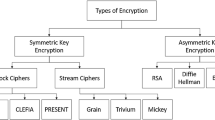Abstract
The existing DNA based image cryptosystems, their DNA coding scheme just employs four DNA symbols, namely A, T, C and G, to represent the four binary two-tuples, namely 00b, 01b, 10b and 11b, respectively. And the used DNA computing algorithms, such as DNA addition and subtraction, are essentially the binary modulo 2 addition and XOR operations without any meanings of genetic engineering, which cannot apply to the DNA computer for processing. So, this paper discussed the DNA coding of image and proposed a new DNA join operation. And the complementary operation of DNA code instead of the complementary operation of binary number is used in the proposed. The piecewise linear chaotic map was employed to generate the key stream. Then, a new DNA based image cryptosystem including two rounds of DNA diffusion and DNA confusion was proposed, which can be rapidly implemented in the DNA computer. The image cryptosystem was simulated with an electronic computer, and the results show that the proposed system possesses the characteristics of large key space, good statistical properties of cipher images, high sensitivities of key and plain images and big information entropy. Therefore, the proposed image cryptosystem is a candidate for the future secure communication application to the DNA computer.










Similar content being viewed by others
References
Belazi A, Hermassi H, Rhouma R, Belghith S (2014) Algebraic analysis of a RGB image encryption algorithm based on DNA encoding and chaotic map. Nonlinear Dynamics 76(4):1–16
Chai X, Chen Y, Broyde L (2017) A novel chaos-based image encryption algorithm using DNA sequence operations. Opt Lasers Eng 88:197–213
Chen GR, Mao YB, Chui CK (2004) A symmetric image encryption scheme based on 3D chaotic cat maps. Chaos, Solitons Fractals 21(3):749–761
Chen JX, Zhu ZL, Fu C, Yu H, Zhang LB (2015) A fast chaos-based image encryption scheme with a dynamic state variables selection mechanism. Commun Nonlinear Sci Numer Simul 20(3):846–860
Cheng P, Yang H, Wei P, Zhang W (2015) A fast image encryption algorithm based on chaotic and lookup table. Nonlinear Dynamics 79(3):2121–2131
Eslami Z, Bakhshandeh A (2013) An improvement over an image encryption method based on total shuffling. Opt Commun 286(1):51–55
Fridrich J (1998) Symmetric ciphers based on two-dimensional chaotic maps. International Journal of Bifurcation and Chaos 8(6):1259–1284
Guesmi R, Farah M, Kachouri A, Samet M (2015) A novel chaos-based image encryption using DNA sequence operation and Secure Hash Algorithm SHA-2. Nonlinear Dynamics 83(3):1–14
Hermassi H, Belazi A, Rhouma R, Belghith S (2013) Security analysis of an image encryption algorithm based on a DNA addition combining with chaotic maps. Multimedia Tools & Applications 72(3):2211–2224
Li SJ, Li Q, Li WM, Mou XQ, Cai YL (2001) Statistical properties of digital piecewise linear chaotic maps and their roles in cryptography and pseudo-random coding. Lect Notes Comput Sci 2260:205–221
Liu L, Zhang Q, Wei X (2012) A RGB image encryption algorithm based on DNA encoding and chaos map. Comput Electr Eng 38(5):1240–1248
Liu Y, Tang J, Xie T (2014) Cryptanalyzing a RGB image encryption algorithm based on DNA encoding and chaos map. Opt Laser Technol 60(2):111–115
Özkaynak F, Yavuz S (2014) Analysis and improvement of a novel image fusion encryption algorithm based on DNA sequence operation and hyper-chaotic system. Nonlinear Dynamics 78(2):1311–1320
Pareschi F, Rovatti R, Setti G (2012) On statistical tests for randomness included in the NIST SP800-22 test suite and based on the binomial distribution. IEEE Transactions On Information Forensics and Security 7(2):491–505
Su X, Li W, Hu H (2016) Cryptanalysis of a chaos-based image encryption scheme combining DNA coding and entropy. Multimedia Tools and Applications. https://doi.org/10.1007/s11042-016-3800-9
Watson JD, Crick FHC (1953) A structure for deoxyribose nucleic acid. Nature 171(4356):737–738
Wong WK (2002) A fast chaotic cryptographic scheme with dynamic look-up table. Phys Lett A 298(4):238–242
Xie T, Liu Y, Tang J (2014) Breaking a novel image fusion encryption algorithm based on DNA sequence operation and hyper-chaotic system[J]. Optik - International Journal for Light and Electron Optics 125(24):7166–7169
Zeng L, Liu R (2015) Cryptanalyzing a novel couple images encryption algorithm based on DNA subsequence operation and chaotic system. Optik 126(24):5022–5025
Zhang Y (2015) Cryptanalysis of a novel image fusion encryption algorithm based on DNA sequence operation and hyper-chaotic system. Optik 126(2):223–229
Zhang Y (2016) The image encryption algorithm with plaintext-related shuffling. IETE Tech Rev 33(3):310–322
Zhang Y (2016) Comments on "DNA coding and chaos-based image encryption algorithm". J Comput Theor Nanosci 13(7):4025–4035
Zhang Q, Liu L (2013) DNA coding and chaos-based image encryption algorithm. J Comput Theor Nanosci 10(2):341–346
Zhang Y, Tang Y (2017) A plaintext-related image encryption algorithm based on chaos. Multimedia Tools and Applications. https://doi.org/10.1007/s11042-017-4577-1
Zhang Q, Wei X (2013) A novel couple images encryption algorithm based on DNA subsequence operation and chaotic system. Optik 124(23):6276–6281
Zhang Q, Guo L, Wei X (2010) Image encryption using DNA addition combining with chaotic maps. Math Comput Model 52(11–12):2028–2035
Zhang Q, Guo L, Wei X (2013) A novel image fusion encryption algorithm based on DNA sequence operation and hyper-chaotic system. Optik 124(18):3596–3600
Zhang Y, Wen W, Su M, Li M (2014) Cryptanalyzing a novel image fusion encryption algorithm based on DNA sequence operation and hyper-chaotic system. Optik 125(4):1562–1564
Zhen P, Zhao G, Min L, Jin X (2016) Chaos-based image encryption scheme combining DNA coding and entropy. Multimedia Tools and Applications 75(11):6303–6319
Acknowledgements
This work was fully supported by the National Natural Science Foundation of China (Grant Nos. 61762043 and 61562035), the Natural Science Foundation of Jiangxi Province, China (Grant No. 20161BAB202058), and the Science and Technology Project of Education Department of Jiangxi Province, China (Grant No. GJJ160426).
Author information
Authors and Affiliations
Corresponding author
Rights and permissions
About this article
Cite this article
Zhang, Y. The image encryption algorithm based on chaos and DNA computing. Multimed Tools Appl 77, 21589–21615 (2018). https://doi.org/10.1007/s11042-017-5585-x
Received:
Revised:
Accepted:
Published:
Issue Date:
DOI: https://doi.org/10.1007/s11042-017-5585-x




